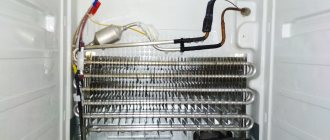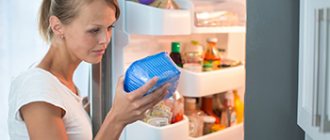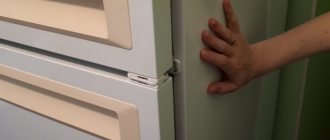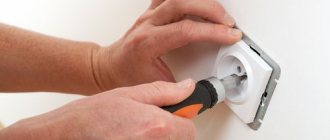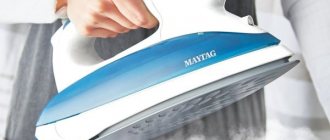Refrigerator Biryusa two-chamber - malfunctions
Biryusa two-chamber refrigerators with one compressor are the main products of the plant. The configuration uses reliable imported units. If the requirements for the operation of the parting are met, problems arise as a result of metal fatigue, exhaustion of seats and wear of seals.
Signs of trouble:
- the compressor runs without stopping;
- the motor does not turn on, or turns on for seconds;
- the cells do not maintain the regime;
- The compressor switches off noisily.
Each of these signs requires diagnosis; there may be several reasons. Some breakdowns of Biryusa refrigerators are minor and can be repaired on your own, while others can be repaired by a professional.
Much depends on the model. It’s easier to find and fix faults in an electromechanical refrigerator with drip defrosting yourself. It is reasonable to entrust a two-compressor refrigerator with electronic control and a No Frost system to a specialist.
Thermostat breakdown in models with electromechanical control – from RUB 1,600*
In Biryusa refrigerators, the thermostat is responsible for regulating the cooling: it determines the temperature in the chambers and gives the motor-compressor commands to turn on and off. Most often, the thermostat fails due to prolonged use, due to moisture ingress, loss of tightness or power surges.
SIGNS
The Biryusa refrigerator does not cool: it is warm in both chambers. The motor does not turn on at all or only turns on for a short time. In this case, the light in the refrigerator compartment comes on when the door is opened. Sometimes, on the contrary, the equipment freezes: the compressor works with short breaks, and a “coat of snow” grows on the back wall of the refrigerator compartment.
HOW TO FIX
A faulty thermostat must be replaced with a new one.
*Prices are only for the work of the master, a new thermostat is paid separately.
Malfunctions of relay P-1 of the Biryusa 3 refrigerator
The most common breakdown in a refrigerator is the failure of the R-1 starting relay. If your refrigerator turns off with a loud click, it's time to replace the relay. This node is identical in Biryusa models 3, 6, 18, 22.
The reasons for incorrect operation may be oxidized contacts of the starting winding. The thermal fuse consists of a spiral and a bimetallic plate in contact. If there is a short circuit in the motor windings, the relay opens the contacts, interrupting the start.
When starting the motor, the device protects the motor winding from increased current, preventing the windings from overheating. After starting, the current decreases and the relay opens.
If a malfunction is detected in relay P1 of the Biryusa refrigerator, it can be repaired by finding the cause:
- burning or melting of contacts;
- destruction of the integrity of the nichrome spiral;
- coil jamming or problems with the rod.
Any breakdown takes a long time to brew, gradually, in the first stages it is easier to eliminate it. Therefore, you need to listen to how the equipment works, clean the ice in time, and remove dust from the rear grille - the condenser.
Refrigerator Biryusa 131K – malfunctions
The model is two-chamber with a bottom-mounted freezer. Electromechanical control, drip defrosting in the positive chamber. The total volume of the refrigerator is 345 l, 4 drawers in the freezer are retractable. Isobutane is used as a refrigerant.
The most common question asked on forums is why the temperature in the upper chamber is higher than the target, but everything is fine in the freezer. Experts consider a common cause to be a lack of refrigerant. But after diagnostics, other breakdowns of the Biryusa refrigerator may also be revealed:
- thermostat malfunction;
- loose seal or door misalignment;
- The light inside the camera does not turn off.
The most expensive operation is refrigerant injection. In order to finally make sure that there is not enough freon in the circuit, you should defrost both chambers. If, after turning on, the freezer stops freezing, you need to check for leaks in the circuit and pump in refrigerant. If the problem arose as a result of mechanical damage, the freezer will need to be replaced.
A removable nuisance is condensation leaking into the freezer, causing lumps to freeze. The reason is a clogged condensate drain from the refrigerator. It needs to be defrosted and cleaned of any crumbs and packaging. Water in the refrigerator compartment indicates a clogged hole, and when the water has nowhere to go, it gradually enters the freezer through leaks.
If there is no lighting in the chamber, the light bulb is working properly, or the refrigerator occasionally generates current, an inspection of the electrical wiring will be required - the insulation of the wires has been broken somewhere.
Refrigerator Biryusa 130 RS - malfunctions
A two-compressor refrigerator with electronic control and automatic defrosting of the cold chamber is one of the modern models that is not inferior to foreign brands in technical parameters. A light indication indicates an increase in temperature in the cells, and an audible signal indicates an open door.
Malfunctions are associated with failure of sensors and relays. It is important that any Biryusa refrigerator is connected through a voltage stabilizer, but for electronic control, unstable power supply is the main cause of failure. Among the malfunctions, the control unit most often fails. The failure of the unit is clearly determined if there is no response to commands. After pressing the “Stop” button for 5 seconds, the display should go out. If this does not happen, other commands are not executed - the master can determine the malfunction.
Freon leakage problems can arise due to poor connection of the tubes to the evaporator. It is necessary to observe whether the doors are warped. The structure is heavy, and the brackets for it are rather weak. But the device has a 3-year warranty, all comments are corrected by the service department free of charge.
Refrigerator Biryusa 18C - malfunctions
Single-compressor models with mechanical control, bottom freezer and automatic defrost are easy to operate. The surface is made of decorative plastic framed with an aluminum corner.
A heater for defrosting ice is attached to the rear cavity of the evaporator. It turns on between compressor cycles. Both chambers are cooled by sheet-tube evaporators.
The main causes of malfunctions are considered to be;
- temperature sensor failure;
- faulty start relay;
- freon leak;
- clogged drain hole and tube.
If the refrigerator or subzero chamber is not working, there may be several reasons. An accurate diagnosis can be made by a specialist based on a combination of symptoms. Perhaps the ice is freezing due to a failure of the defrost thermostat; the drainage tube is not only clogged, but cracked. The absence of freon in the system or a plug in the capillary will help determine the temperature of the condenser.
If the reason is in the thermostat
As a rule, the thermostat in the refrigerator is located on the front panel or in the chamber of the device, and is designed to set the required temperature. The most common malfunction of this element is the stem sticking out. You just need to put it in place. However, in some cases, the cause of the malfunction may be the failure of the thermostat (for example, due to a short circuit in its housing after water enters due to inaccurate defrosting), and then its replacement is also necessary.
Read also: Scope of application of rolling bearings
Malfunctions of the Biryusa 226C refrigerator
The two-chamber model with a bottom freezer has one compressor and an electromechanical thermostat. Energy efficiency class of the refrigerator Biryusa 226C - C.
Often, loss of cooling is due to a faulty thermostat. The breakdown is accompanied by signs:
- The refrigerator motor does not turn on, the cooling does not work, and the light in the compartment is on;
- the compressor runs without interruption;
- the refrigerator is very cold, food freezes in the plus chamber;
- The refrigerator does not freeze, while the thermostat knob is in the working position.
The purpose of the thermostat is to read sensor readings in the chambers and regulate the operation of the compressor. In case of failure, a comprehensive repair of the unit is required.
Other reasons may be a malfunction of the cooling circuit associated with a freon leak. A failure of the start relay or a malfunction of the compressor is determined by a specialist.
Basic faults
So, now we’ll do the following: we’ll look at each cause of the breakdown in turn and how to repair it ourselves.
- The door does not close tightly. In fact, this is a very commonplace option, but we still encounter this often. The point is not even that you did not close the door completely; perhaps the rubber seals have simply worn out and need to be replaced. How does this relate to the refrigerator not turning off? Everything is very simple - warm air enters one of the chambers, as a result of which it heats up. The temperature sensor sends a signal to the “brains” that the chamber needs to be cooled, and as a result, a closed cycle occurs: heat penetrates under the seal, and the compressor tries to lower the temperature by working without shutting down. At the same time, it seems to you that the equipment does not freeze at all or does not cool well, but it works. You can do the replacement yourself, the main thing is to find the same seal and carefully stick it on.
- You have set this operating mode. As we said above, inattention and setting the temperature as low as possible can be the reason why the refrigerator runs and does not turn off all day. The cooling parameters need to be checked immediately, and then look for other possible faults.
- High room temperature. When we looked at tips for choosing a refrigerator for your home, we paid attention to the fact that each appliance has its own climate class - the temperature conditions under which the device can operate. For example, if you installed equipment in a room where it is +30 o C, the compressor will naturally work without stopping. In this case, you need to move the refrigerator to a cooler room.
- The thermostat has failed. If the reason is electrical, it is a malfunction of the thermostat or temperature sensor. In this case, you need to ring the product with a multimeter and if you find that when the set point is reached, the relay does not open the contacts, replace it. Replacing the thermostat or temperature sensor (depending on what is not working) with a new one will not be difficult.
- The compressor has broken down. It also happens that the compressor works without interruption because it cannot “catch up” to the set temperature, so the refrigerator makes noise and does not turn off or does so rarely. At this point you will have to replace the part with a new one, unless, of course, the cause of the breakdown is trivial - placing the equipment in a warm room or damage to the seals. Replacing a compressor is not at all difficult; the main thing is to choose a model with the same characteristics.
- Refrigerant has leaked from the system. It is extremely difficult to repair a leak with your own hands; in this case, you will have to call a specialist, whose work can cost up to 3,500 rubles. If you yourself know how to add freon to the system, do it and observe the equipment after refueling - whether the refrigerator turns off or works constantly and does not turn off.
Read also: What is the difference between a torch and a cutter?
How to replace the thermostat in a refrigerator that does not turn off, watch this video:
Finally, I would like to note that the refrigerator malfunctions listed above can occur even in modern models with the no-frost function and other additional parameters. We recommend browsing thematic forums to view information about your specific equipment manufacturer, for example, Indesit or Ariston. Very often, people who have encountered a similar problem describe it in detail with all the smallest nuances. This way you will know exactly what needs to be done for repairs and, in fact, why the failure occurred.
So we have provided a list of the most popular malfunctions, in the event of which the refrigerator constantly works, without stopping, and may even cool slightly. We draw your attention to the fact that if the equipment operates for a long time without a break and you do not take repair measures, the compressor will soon fail, which will entail higher costs! It’s better to do everything on time, because... sometimes if the cooling process does not turn off, it is enough to simply replace the thermostat or move the housing out of the heat.
Also read:
Malfunctions of the Biryusa-18 refrigerator
The refrigerator is two-chamber, assembled in a metal case, painted white. Energy efficiency - class C device. One compressor with a common cooling circuit. The refrigeration chamber is equipped with a T-130 thermostat, a VOK-2 switch and a 15 V incandescent lamp. An evaporator defrost is installed in the chamber and is turned on by the T-130 signal.
The cause of ice freezing in the refrigerator compartment may be a malfunction of these components or the influx of fresh air through leaks in the door. Diagnostics of models 18 and 18 C are the same. They are distinguished only by their appearance. The refrigerator compartment does not work - watch how to diagnose and repair in the video.
Malfunctions of the Biryusa-22 refrigerator
The Biryusa 22 refrigerator is two-door, the freezer is on top. There are two operating positions on the installation panel - “Storage” and “Freezing”. The control unit has a voltage indicator and a middle bar heating switch. The temperature in the chambers is set using a common regulator with graduation in 7 positions.
You can independently eliminate only some problems associated with improper installation of the device or contact of tubes with the housing or other components. You can separate them a little or put soft spacers. Tighten the bolts. Check whether the installation of the refrigerator complies with the requirements of the operating instructions. If a smell occurs, you need to wash and ventilate the chamber and replace the burnt out light bulb. Experts are called when irreparable problems arise.
Typical malfunctions of the Biryusa 22 refrigerator:
- The electrical wiring is broken, current passes through the housing, and the light in the chamber does not turn on. Here the voltage in the network, contacts with terminals in the relay, and winding resistance are checked.
- The thermostat is faulty. The reasons are a breakdown in the electrical circuit or a malfunction of the bellows tube, but the thermostat needs to be changed in any case.
- Faulty compressor or start relay.
- Refrigerant leak or capillary tube clogged.
- If a fur coat grows on the evaporator, the heater is not working, the reason is the thermostat or a malfunction of the device itself.
- The heater on the partition does not work, the condensate does not evaporate.
The Biryusa 22 refrigerator has been operating for decades without breakdowns if the manufacturer’s requirements are met. You need to remember that the device will not cool well if the room temperature is below +16 and above 35 degrees, and there is high humidity in the room. This is not considered a breakdown, the climate class of the device is N.
Refrigerator repair Biryusa
25 September 2006
Author:
https://www.elremont.ru
| Refrigerator type | Compression | Defrosting the refrigerator compartment evaporator | Semi-automatic |
| Number of cameras | 2 | Electricity consumption at air temperature 25°C, kWh/day | 1,9 |
| Total volume, dm3 | 260 | Overall dimensions, mm | 1455x580x600 |
| Low-temperature chamber volume, dm3 | 60 | Weight, kg | 72,5 |
| Temperature in the low-temperature chamber, °C | -18 | ||
| Power consumption, W | 180 |
Refrigerator device.
The refrigerator is two-chamber, made in the form of a floor cabinet. The body of the refrigerator cabinet and door frames are made of steel sheet followed by the application of a protective and decorative coating, the inner cabinet and door panels are made of plastic. Thermal insulation is polyurethane foam.
On the side wall of the refrigerator compartment there is an instrument block that contains a T-130 thermostat, a VOK-2 switch and an RN 220-15-1 electric lamp. The lamp automatically lights up when the door is opened and goes out when closed.
Defrosting of the refrigeration chamber evaporator is automatic, during the non-working part of each operation cycle of the refrigeration unit, which is ensured using a T-130 thermostat with a positive switching temperature and a heater mounted on the rear plane of the evaporator.
The design of the internal cabinet and door panel in the refrigeration chamber allows for the rearrangement of shelves and barriers in height with an interval of 50 mm. The shelves can be removed from the refrigerator compartment when the door is opened 90°. The design of refrigerators provides for the possibility of reversing the doors so that they open from right to left. Doorways are sealed with an elastic seal and a magnetic insert. The low-temperature and refrigeration chambers are cooled using sheet-tube evaporators.
Rice.
1 Electrical diagram of the Biryusa-18 refrigerator:
| M — compressor ХКВ6-1ЛБУ; | H1,H2 - electric heaters; |
| K - relay P1: | X - distribution block; |
| T — thermostat T130; | B, K, C - wire color ( K - brown, B - white, C - blue); |
| S —switch VOK-2; | 1, 2, 3, 4, 5 - numbers on the distribution block |
| L – lamp RN 220-15-1: |
Refrigerator repair
Replacing refrigerator doors
- Open the doors, remove barriers and vessels located on the refrigerator door panel.
- Unscrew the screws, remove the grille and pull out the trim.
- Unscrew the bolts, lift the hinge and remove the refrigerator door.
- By rotating the nut, disengage the axle from the bracket and remove the door of the low-temperature chamber.
- Replace the door and hang it in the reverse order.
Replacing the refrigeration unit
- Remove all shelves, barriers and containers from the refrigerator. Remove the doors.
- Loosen the screws and disconnect the bellows tube from the refrigerator compartment evaporator.
- Remove the electrical wiring casing, disconnect the plate clamps of the electric heater of the refrigerator compartment evaporator, the middle bar heater and the instrument block.
- Disconnect the instrument panel from the cabinet.
- Remove the middle bar and plate.
- Having lowered the electric heater of the middle strip onto the upper shelf of the evaporator of the low-temperature chamber, remove the partition.
- Push in the pins, remove the bushings and remove the tray. Remove the pins and move the refrigerator compartment evaporator away from the cabinet wall.
- Remove the pipeline cover and pipeline insulation.
- Disconnect the condenser from the back wall of the refrigerator.
- Remove the outer flange, remove the thermal insulation of the hatch and the inner flange by deforming the latter, after first removing the clamp from it.
- Disconnect the plug block from the compressor.
- Turn the latches to release the compressor from the base of the cabinet.
- Remove the pins and bushings securing the evaporator shelves of the low-temperature chamber to the cabinet, fold them like a ladder, and bring them out through the cabinet hatch.
- Replace the unit.
- Reassemble in reverse order.
Gutter replacement
- Disconnect the condenser from the back wall of the refrigerator.
- Remove the water seal from the cabinet opening, separating it from the tray.
- Disconnect the drain from the vessel. Repair or replace defective parts.
- Reassemble in reverse order.
Replacing the electric heater for the refrigeration chamber evaporator
- Remove the electrical wiring casing, disconnect the plate clamps of the electric heater of the refrigerator compartment evaporator, the electric heater of the middle strip and the instrument block.
- Remove the pins and move the refrigerator compartment evaporator away from the cabinet wall.
- Replace the heater.
- Reassemble in reverse order.
Replacing the middle rail electric heater
- Remove the doors.
- Remove the electrical wiring casing, disconnect the plate clamps of the electric heater of the refrigerator compartment evaporator, the electric heater of the middle strip and the instrument block.
- Remove the middle bar and plate.
- Lower the electric heater of the middle strip onto the upper shelf of the evaporator of the low-temperature chamber, remove the partition.
- Push in the pins, remove the bushings and remove the tray.
- Move the refrigerator compartment evaporator away from the cabinet wall.
- Remove the pipeline cover and pipeline insulation.
- Replace the electric heater.
- Reassemble in reverse order.
Replacing the panel on the refrigerator door
- Remove the latches and screws.
- Remove the magnetic seal from the panel.
- Replace the panel and secure it to the door.
- Reassemble in reverse order.
Electrical wiring repair
- Loosen the screws and disconnect the bellows tube from the refrigerator compartment evaporator.
- Remove the electrical wiring casing and disconnect the plate clamps of the electric heater of the refrigerator compartment evaporator, the electric heater of the middle strip and the instrument block.
- Disconnect the instrument panel from the cabinet.
- Remove the pins and move the refrigerator compartment evaporator away from the cabinet wall.
- Disconnect the condenser from the back wall of the refrigerator.
- Remove the outer flange, remove the thermal insulation of the hatch and the inner flange by deforming the latter, after first removing the clamp from it.
- Disconnect the plug block from the compressor and, lifting the evaporator of the refrigerator compartment, bring the instrument block outside through the cabinet hatch.
- Remove the block and cover.
- Carry out repair work on the electrical wiring of the refrigerator.
- Reassemble in reverse order.
| Refrigerator type | Compression | Defrosting the refrigerator compartment evaporator | Semi-automatic |
| Number of cameras | 2 | Electricity consumption at air temperature 25°C, kWh/day | 1,5 |
| Total volume, dm3 | 255 | Overall dimensions, mm | 1450x580x600 |
| Low-temperature chamber volume, dm3 | 85 | Weight, kg | 67 |
| Temperature in the low-temperature chamber, °C | -18 | ||
| Power consumption, W | 135 |
The household two-chamber refrigerator BIRYUSA-22 KShD-255 is designed for storing chilled and frozen foods, preparing edible ice and cooling drinks at home. The refrigerator can operate in the “Freezing” mode.
Rice.
2 Appearance and structure of the Biryusa-22 refrigerator
Fig.
3 Scheme for removing melt water
The refrigerator has a number of comfort elements: the ability to rehang the doors for right- or left-hand opening, as well as rearrange shelves and barriers in height at intervals of 50 mm; limiting the opening angle of the refrigeration chamber door; the presence of a system for automatically defrosting the refrigeration chamber evaporator and removing melt water outside the refrigerator with subsequent evaporation. The refrigerator is equipped with light signaling for operating modes (“Freezing” and “Storage”).
The refrigerator is made in the form of a floor cabinet, divided into two chambers, each with its own door. In the lower refrigerator compartment the temperature is maintained at 0...10°C, in the upper low-temperature (freezing) compartment for storing frozen food the temperature is -18°C. The refrigerator is made with a mounting plane; a control and alarm unit is built into its edging, which consists of an operating mode switch that provides two modes of operation of the freezer compartment (“Freezing” and “Storage”), a voltage indicator and an electric heating switch for the middle bar.
The electric heater of the middle strip is turned on by a switch when condensation (moisture) appears on the front surface of the middle strip. Condensation may occur when the ambient humidity is high. The electric bar heater can remain switched on continuously. The temperature in the refrigerator is set using the thermostat knob. The mode is supported automatically; in this case, in case of insufficient cooling, the knob is turned clockwise, in case of overcooling - in the opposite direction. The thermostat knob is marked with a scale from 1 to 7 (0—turns off the refrigerator). On the side wall of the refrigerator compartment there is an instrument block, which consists of a light bulb, a thermostat and a switch. When replacing a light bulb, you must remove the lens.
Rice.
4 Electrical diagram of the Biryusa-22 refrigerator with an electric heater switch:
| M - compressor; | H2 - middle level electric heater 220 V, 5 W; |
| K - start-protection relay; | L - light bulb (220 V, 15 W); |
| T - thermostat, | HL — indicator (green); |
| SB - switch; | SA1 —slat electric heater switch; |
| H1 - evaporator electric heater (220 V, 12 W); | SA2 - operating mode switch; |
| X - distribution block; |
Rice.
5 Electrical diagram of the Biryusa-22 refrigerator without an electric heater switch:
| M - compressor; | L - light bulb 220 V, 15 W; |
| K - start-protection relay; | SA – switch for “Freezing” and “Storage” operating modes (orange); |
| T - thermostat: | HL —indicator (green); |
| B - switch; | X - distribution block; switch |
| H1 - electric heater 220 V, 15 W: | SB is shown in the position when the refrigerator door is open |
| H2 - electric heater 220 V, 5 W: |
Typical refrigerator malfunctions and repairs
| Cause | Remedy |
| Knocking, noise, rattling | |
| The refrigerator is not installed correctly | Ensure that the refrigerator is in a stable position using the adjustable supports. |
| The piping of the refrigeration unit touches the metal structures of the refrigerator, floor or wall | Carefully bend the tube at the point of contact |
| Odor in the refrigerator compartment | |
| Improper maintenance of the refrigerator (poor quality packaging of stored food or medicines that emit odors) | It can be eliminated by the consumer himself by thorough washing and ventilation. Repairs are not covered under warranty |
| No lighting in the refrigerator compartment | |
| Bulb faulty | Replace the light bulb |
| The contact system of the switch or socket is broken | Check by external inspection, if possible, then eliminate, if not, then replace the cartridge or switch |
| Presence of signs of short circuit | |
| The insulation of the electrical circuit of the refrigerator is broken | Check the insulation resistance: between the live parts of the plug and the refrigerator body; between the compressor output contacts and the refrigerator body: between the electric heater terminals and the refrigerator body. The insulation resistance must be at least 2 MOhm. If the resistance is low, replace unusable electrical wiring elements, check for mechanical damage and determine the location of the insulation breakdown |
| The refrigerator does not turn on | |
| Low or no voltage in the electrical network | Check the network voltage with a voltmeter (voltage should be 187...242 V) |
| Contact between plug and socket is broken | Check the serviceability of the plug and socket |
| The connection of the wires to the terminals of the relay, thermostat or between the feed-through contacts and sockets is broken | Check the ohmic resistance of the electrical network of the refrigerator. The resistance of the working winding of the electric motor should be 14... 16 0m |
| Faulty thermostat: a) the electrical circuit is broken; b) refrigerant leak from the bellows tube | Check the thermostat circuit. When the temperature in the refrigerator compartment is above 8°C, the electrical circuit of the thermostat must be closed. A faulty thermostat must be replaced |
| Faulty electric motor | Check the resistance in the motor windings when cold. The operating resistance should be 14..16 Ohms, the starting resistance - 40...32 Ohms. If the resistance in the engine is low, replace the unit. When replacing the thermostat and start-protection relay, check the integrity of the factory seal |
| No cooling when compressor is running | |
| Refrigerant leakage from the unit's piping system | Determine the location of the refrigerant leak by the presence of oil stains on the pipelines of the unit or with a leak detector. Check the power consumption of the refrigerator. In the absence of refrigerant, power consumption is less than 120 W. If a defect is found, replace the unit |
| Clogged capillary tube | The power consumption of the refrigerator within 3...5 minutes after switching on is 150...165 W, then drops to 120 W. The evaporator inlet is warm. If there is a defect, replace the unit |
| The refrigerator is unstable (the evaporator cools and warms while the compressor is running) | |
| Freezing of moisture in the capillary tube | Remove the partition, heat the end of the capillary tube at the entrance to the evaporator pipe while the compressor is running. As a result of heating, a characteristic hissing of the refrigerant entering the evaporator will be heard, and the evaporator will begin to freeze. If there is a defect, replace the unit |
| The refrigerator runs continuously | |
| Partial refrigerant leak from the unit system | Determine the location of the leak by the presence of oil stains on the pipelines and using a leak detector. If there is a defect, replace the unit |
| The bellows tube of the thermostat touches the electric heater located on the rear wall of the evaporator of the refrigerator compartment | Eliminate Touch |
| A snow “coat” is constantly growing on the evaporator of the refrigerator compartment | |
| The electric heater on the evaporator does not work | Check the quality of connection of the electric heater terminals and electrical wiring. Check the resistance of the electric heater by disconnecting the terminals from the electrical wiring. The resistance should be 4000...5000 Ohms. You can connect the electric heater to the network. In this case, the power consumption should be within 10...12 W. The electric heater should feel warm to the touch. |
| Moisture condenses on the partition between the doors | |
| The electric heater in the partition does not work | Check the electric heater according to the method outlined above. Power consumption should be within 5...6 W |
| Refrigerator type | Compression | Defrosting the refrigerator compartment evaporator | Semi-automatic |
| Number of cameras | 2 | Electricity consumption at air temperature 25°C, kWh/day | 1,5 |
| Total volume, dm3 | 255 | Overall dimensions, mm | 1435x580x600 |
| Low-temperature chamber volume, dm3 | 85 | Weight, kg | 65 |
| Temperature in the low-temperature chamber, °C | -18 | ||
| Power consumption, W | 135 |
The household two-chamber refrigerator BIRYUSA-22-1 KShD-255 is designed for storing chilled and frozen foods, preparing edible ice and cooling drinks at home.
Rice.
6 Appearance and structure of the Biryusa-22-1 refrigerator
Refrigerators have a number of comfort elements: the ability to rehang the doors for right- or left-hand opening, as well as rearrange shelves and barriers in height at intervals of 50 mm; limiting the opening angle of the refrigerator door; the presence of a system for automatically defrosting the evaporator of the refrigeration chamber and removing melt water outside the refrigerator with subsequent evaporation.
The refrigerator is made in the form of a floor cabinet, divided into two chambers, each with its own door. In the lower refrigerator compartment the temperature is maintained at O...10°C, in the upper low-temperature (freezing) compartment for storing frozen food the temperature is -18°C.
The electric heater of the middle strip is turned on by a switch when condensation (moisture) appears on the front surface of the middle strip. Condensation may occur when the ambient humidity is high. The electric bar heater can remain on constantly, without the need to monitor the appearance of condensation on the middle bar.
The temperature in the refrigerator is set using the thermostat knob. The mode is supported automatically; in this case, in case of insufficient cooling, the knob is turned clockwise, in case of overcooling - in the opposite direction. The thermostat knob is marked with a graduation from 1 to 7 (0 means the refrigerator is turned off).
Fig.7
Electrical diagram of the Biryusa-22-1 refrigerator:
| M - compressor; | SB - switch: |
| K - start-up protection turnip; | L - light bulb (220 V, 15 W); |
| T - thermostat; | X - distribution block |
| H1 - evaporator electric heater (220 V, 12 W); | |
| H2 - middle level electric heater (220 V, 5 W); |
Typical refrigerator malfunctions and repairs
| Cause | Remedy |
| Knocking, noise, rattling | |
| The refrigerator is not installed correctly | Ensure that the refrigerator is in a stable position using the adjustable supports. |
| The piping of the refrigeration unit touches the metal structures of the refrigerator, floor or wall | Carefully bend the tube at the point of contact |
| Presence of signs of short circuit | |
| The insulation of the electrical circuit of the refrigerator is broken | Check the insulation resistance: between the live parts of the plug and the refrigerator body; between the compressor output contacts and the refrigerator body; between the terminals of the electric heaters and the refrigerator body. The insulation resistance must be at least 2 MOhm. If the resistance is low, replace unusable electrical wiring elements, check for mechanical damage and determine the location of the insulation breakdown |
| Odor in the refrigerator compartment | |
| Improper maintenance of the refrigerator (poor quality packaging of stored food or medicines that emit odors) | It can be eliminated by the consumer himself by thorough washing and ventilation. Repairs are not covered under warranty |
| No lighting in the refrigerator compartment | |
| Bulb faulty | Replace the light bulb |
| The contact system of the switch or socket is broken | Check by external inspection, if possible, then eliminate, if not, then replace the cartridge or switch |
| The refrigerator does not turn on | |
| Low or no voltage in the electrical network | Check the network voltage with a voltmeter (voltage should be 187..242 V) |
| Contact between plug and socket is broken | Check the serviceability of the plug and socket |
| The connection of the wires to the terminals of the relay, thermostat or between the feed-through contacts and sockets is broken | Check the ohmic resistance of the electrical network of the refrigerator. The resistance of the working winding of the electric motor should be 14…16 Ohms |
| Faulty thermostat: a) the electrical circuit is broken; b) refrigerant leak from the bellows tube | Check the thermostat circuit. When the temperature in the refrigerator compartment is above 8°C, the electrical circuit of the thermostat must be closed. A faulty thermostat must be replaced |
| Faulty electric motor | Check the resistance in the motor windings when cold. The operating resistance should be 14...16 Ohms, the starting resistance - 40...32 Ohms. If the resistance in the engine is low, replace the unit. When replacing the thermostat and start-protection relay, check the integrity of the factory seal |
| No cooling when compressor is running | |
| Refrigerant leakage from the unit's piping system | Determine the location of the refrigerant leak by the presence of oil stains on the pipelines of the unit or with a leak detector. Check the power consumption of the refrigerator. If there is no refrigerant, the power consumption is less than 120 W. If a defect is found, replace the unit |
| Clogged capillary tube | The power consumption of the refrigerator within 3...5 minutes after switching on is 150-165 W, then drops to 120 W. The evaporator inlet is warm. If there is a defect, replace the unit |
| The refrigerator is unstable (the evaporator cools and warms while the compressor is running) | |
| Freezing of moisture in the capillary tube | Remove the partition, heat the end of the capillary tube at the entrance to the evaporator pipe while the compressor is running. As a result of heating, a characteristic hissing of the refrigerant entering the evaporator will be heard, and the evaporator will begin to freeze. If there is a defect, replace the unit |
| The refrigerator runs continuously | |
| Partial refrigerant leak from the unit system | Determine the location of the leak by the presence of oil stains on the pipelines and using a leak detector. If there is a defect, replace the unit |
| The bellows tube of the thermostat touches the electric heater located on the rear wall of the evaporator of the refrigerator compartment | Eliminate Touch |
| A snow “coat” is constantly growing on the evaporator of the refrigerator compartment | |
| The electric heater on the evaporator does not work | Check the quality of connection of the electric heater terminals and electrical wiring. Check the resistance of the electric heater by disconnecting the terminals from the electrical wiring. The resistance should be 4000...5000 Ohms. You can connect the electric heater to the network. In this case, the power consumption should be within 10...12 W. The electric heater should feel warm to the touch. |
| Moisture condenses on the partition between the doors | |
| The electric heater in the partition does not work | Check the electric heater according to the method described above. Power consumption should be within 5…6 W |
Good luck with the renovation!
The article was prepared based on materials from the book “Refrigerators from A to Z” by S.L. Koryakin-Chernyak
All the best, write
to Elremont © 2006
